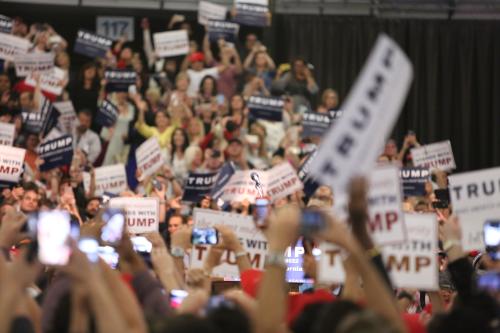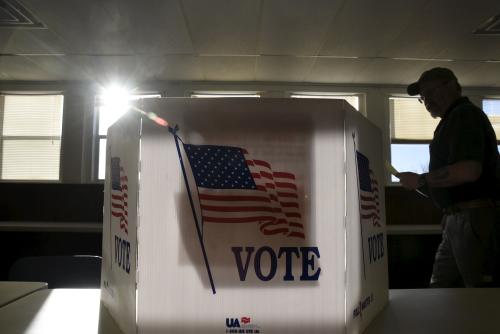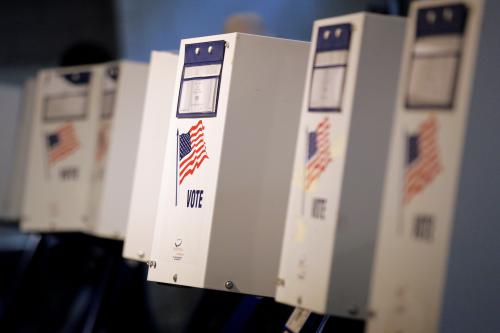Much has been written about the centrality of the white working class to Donald Trump’s rise to prominence as the Republican nominee. This demographic bloc was pivotal to his primary wins and has been his target audience in the general election campaign. Even as national polls show Trump losing badly to Hillary Clinton, many of his supporters hold the hope that a resurgent turnout of “hidden voters” from this base—comparable to what fueled the Brexit referendum in Britain—will provide him a route to victory.
Can an extraordinarily high turnout of the white working class produce a Trump victory on Nov. 8? It is clearly the case that the white working class, identified here as whites who are not college graduates, has been underrepresented among the voting population in prior elections. As Figure 1 indicates, the turnout on Election Day of non-college white eligible voters is consistently lower than that of college educated whites, a difference of 57 and 79 percent, respectively, in 2012. This pattern of lower turnout among non-college whites is evident in all states, especially the “white” Rust Belt states that Trump is counting on winning.

These numbers suggest that the white working class bloc has a high ceiling of potential voting power, if it could be energized to increase its turnout. Non-college whites have long demonstrated greater support for Republican candidates than have white college graduates, providing Republicans a substantial counterweight to the strong Democratic support of racial minorities.
In 2012, non-college whites, who did vote, registered a Republican vote margin (Republican vote percent minus Democratic vote percent) of 22 percent compared with a Republican vote margin of 11 percent among college educated whites who voted. In contrast, racial minority voters showed a Democratic margin (Democratic vote percent minus Republican vote percent) of 64 percent.
This year’s polls suggest an even greater divergence between the Republican support from the white working class and other groups, and white college graduates in particular, many of whom will vote Democratic for the first time in decades. For this reason, greater white working class turnout is especially crucial to Trump’s cause.
Impact of high turnout from white working class voters
To understand what a super-sized white working class turnout could mean for the coming election, I conducted simulations of three possible turnout scenarios. Scenario 1 assumes that each group—non-college whites, college educated whites, and minorities—would turn out at the same rates as in the 2012 election. Scenario 2 alters this by assuming that non-college white turnout rates increase by 10 percent (to 67 percent, nationally). And Scenario 3 makes the highly improbable assumption that non-college whites will turn out to vote at the same rate as college educated whites (79 percent).
The estimated number of 2016 voters under these three scenarios are depicted in Figure 2 where the only differences occur with the numbers for non-college whites whose voter populations rise from 57 million in Scenario 1, to 67 million in Scenario 2, and 79 million in Scenario 3.
 Election outcomes: The popular vote
Election outcomes: The popular vote
What would these three turnout scenarios imply for the election’s outcome? To ascertain this, one must first stipulate how each group would vote with respect to Trump or Clinton.
For non-college whites, I attributed a Republican margin of 32 percent, which is 10 points higher than in 2012. As for college educated white voters, I posited that their vote will be evenly split between Clinton and Trump with a Democrat or Republican margin of 0—given their lack of enthusiasm for Trump this year, especially among white college educated women. Finally, for the minority population, I attributed the same Democratic margin, 64 percent, as was observed in 2012.
Once I apply these attributed Republican (Trump) and Democratic (Clinton) margins to the estimated numbers of voters in the three turnout scenarios above we see the following outcomes for the national popular vote:
Scenario 1, which does not inflate non-college white turnout rates from those of 2012, shows a Clinton winning by 6.6 million votes with a margin of 4.8 percent. Under Scenario 2, which increases the non-college white turnout by 10 percent, Clinton still wins but only by 3.4 million votes and with a margin of 2.3 percent.
However, in Scenario 3, which makes the extraordinary assumption that non-college white turnout equals college educated white turnout (an increase of 22 points from 2012) and no increase in turnout for other groups, Trump would indeed win the popular vote but by less than 500,000 votes and with a margin of 0.3 percent.
Election outcomes: The Electoral College
Of course, Trump winning the popular vote, even under an extreme turnout scenario, does not necessarily translate to an Electoral College victory. To gain some sense of what the possible electoral outcomes could be, I conducted similar simulations for 10 swing states, shown in the table below, for the three different turnout scenarios for non-college whites.
As with the U.S. popular vote simulations, I stipulated each state’s Republican and Democratic margins as follows: for non-college whites, I added 10 Republican margin points to the 2012 margin; for college whites, I assumed an even Republican and Democratic vote split; and for minorities, I posited the same Democratic margin as in 2012.

When 2012 turnout rates are assumed for non-college whites in Scenario 1, Clinton wins in all of these states except Ohio, where Trump wins by only a 0.2 percent margin- a virtual toss-up. Increasing non- college white margins by an additional 10 points, in Scenario 2, adds Pennsylvania to Trump’s column by a tiny 0.2 percent margin; though his Ohio margin rises to 2.5 percent.
Finally, “the supersized turnout” Scenario 3 does bring to Trump an additional state, Wisconsin, and one more, Iowa, is within striking distance. Yet even with this scenario, and giving Iowa to Trump, Clinton would still win the Electoral College 293 to 245, if all other states voted the way they did in 2012.
It is fair to say that all of these simulations probably overstate the support that Trump will receive irrespective of turnout rates. Compared with national polls taken in early and mid-October , I have attributed greater Trump voting margins to non-college whites, and less Clinton support to college educated whites.
Furthermore, I did not consider previously Republican-voting Arizona and Georgia as the potential swing states they could become if there is high turnout and support among their sizeable Hispanic and black populations.
Presented here is more than a best-case scenario for the impact the white working class can have in support of Donald Trump. What this analysis makes plain is that even in the rosiest of scenarios, an extraordinary turnout of white working class voters, by itself, cannot produce a Trump victory. Thus, the “hidden voter” theory appears to be highly overblown.






Commentary
Can “hidden” white working class voters deliver a Trump victory?
October 31, 2016